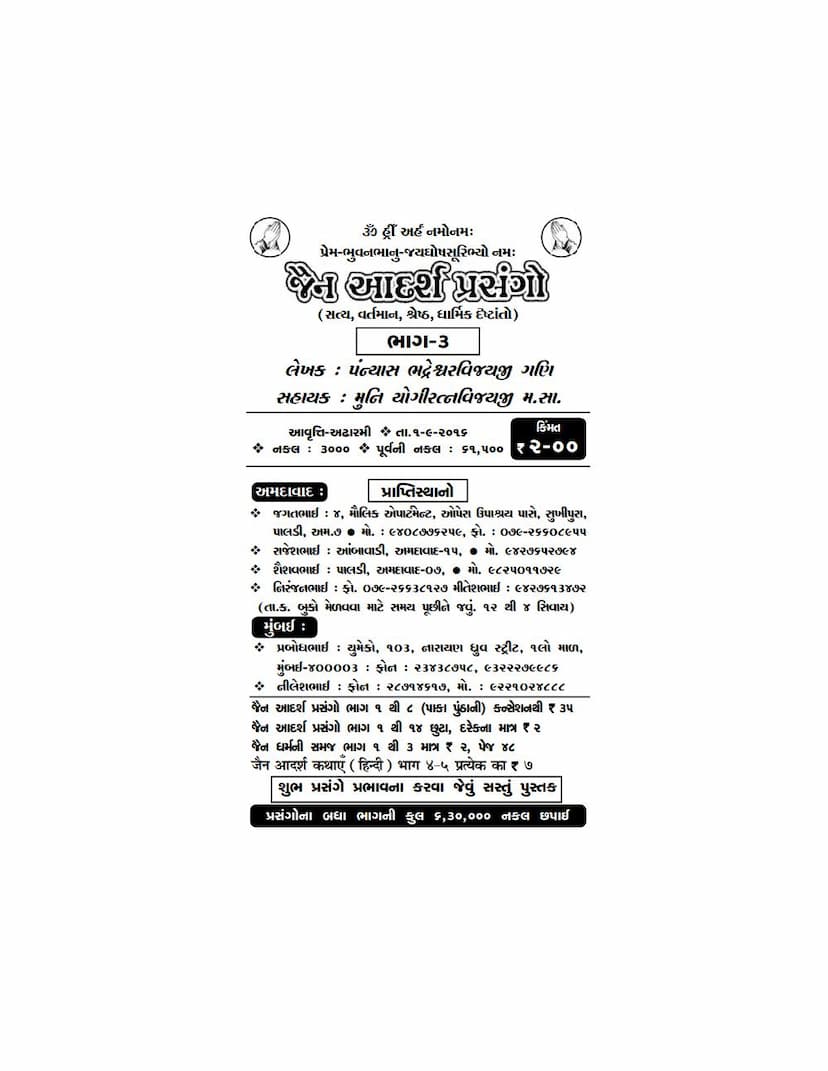Jain Adarsh Prasango Part 03
Added to library: September 1, 2025

Summary
Here is a comprehensive summary of the Jain text "Jain Adarsh Prasango Part 03," based on the provided content:
Book Title: Jain Adarsh Prasango Part 03 (Jain Ideal Incidents Part 03) Author: Nyas Bhadreswarvijayji Gani Assistant: Muni Yogiratnavijayji M.Sa. Publisher: Bhadreswarvijay Theme: The book compiles inspiring true stories of individuals who have embodied Jain principles, showcasing the power of faith, adherence to vows, austerities (tapasya), renunciation (sanyam), and virtuous living. These incidents serve as religious examples and moral guidance.
Overall Purpose: The collection aims to motivate readers to adopt a more spiritual and ethical lifestyle by presenting relatable and impactful real-life examples of individuals achieving spiritual progress, overcoming challenges, and attaining positive outcomes through their adherence to Jain teachings.
Key Themes and Categories of Stories:
The table of contents (Page #2) indicates that the book is organized into broad categories of spiritual practice:
- Sanyam (Restraint/Renunciation): Stories focusing on individuals embracing the monastic life or strict self-discipline.
- Tapasya (Austerities): Narratives highlighting the practice of fasting, vows, and other self-mortifications for spiritual purification and merit.
- Samadhikaran (Equanimity/Peaceful Mindset): Accounts of individuals maintaining mental peace and composure, especially during difficult times or at the time of death.
- Consequences of Religious Criticism/Actions: Stories illustrating the karmic repercussions of both speaking against and acting in accordance with religious principles.
- Miracles of the Navkar Mantra: Examples of the power and efficacy of reciting the sacred Navkar mantra.
Highlights and Specific Examples (from the provided pages):
The book presents numerous stories, often with specific details about the individuals, their circumstances, and the outcomes of their actions. Here are some prominent examples from the initial pages:
-
Shreemant Vruddh Diksha Lidhi (A Wealthy Elder Took Initiation): This story (Page #4) is about Deepakbhai from Ahmedabad, who, inspired by reading, decided to retire at 60. After witnessing religious practices, his desire for initiation grew. Despite his age (68) and initial refusal by his Acharya due to old age, he persisted and received initiation from Acharya Shri Bhuvanbhanusurishwarji M. He has been practicing asceticism for 14 years, demonstrating that even in the Kaliyug, wealthy and elderly individuals can bravely pursue self-welfare.
-
Kishore Tirthyatra ma Adhai Kari (A Teenager Performed Austerities During Pilgrimage): This narrative (Page #5) tells of Premchand, a 16-year-old who, during a pilgrimage to Palitana, was so filled with joy that he performed an "Adhai" (a specific type of fast). This pilgrimage and tapasya purified his karma, leading to the desire for renunciation. He eventually took initiation from Acharya Shri Vijay Daan Surishwarji M. and led a highly virtuous life, becoming a shining star of Jainism. His strict celibacy was so profound that reciting his name (Gurudev Shri Prem Suri) brought spiritual benefits.
-
College-going Young Woman Became a Queen: This story (Page #6-8) features a young woman from Ooty (the "Queen of Hills") who, despite her privileged upbringing, education, and social life, felt an inner emptiness. Influenced by her mother's religious upbringing and an early encounter with Acharya Shri Vijay Bhaguptasuriya M., she developed a strong inclination towards renunciation. She found true happiness and spiritual satisfaction in the monastic life, renouncing worldly pleasures for the pursuit of the soul's true well-being. The story emphasizes the importance of spiritual knowledge and the emptiness of material happiness.
-
Instead of College Admission, Renunciation: This account (Page #9-12) concerns Divya, whose father, Pankajbhai, was hesitant to send her to college due to the potentially negative influences of the modern world. He proposed she undergo a religious observance ("Upadhan") first. Through this process, Divya developed a deep respect for Dharma, discarded her old clothes, and ultimately decided against college, eventually seeking initiation. Her father's initial apprehension gave way to pride as he saw her dedication. The story highlights how even individuals not strictly religious can be drawn to spiritual paths and the importance of not despising those who are not yet religious.
-
From Samayik to Acharya: This story (Page #12-13) is about a young boy who, during a camp, was inspired by the competition to perform "Samayik" (a period of meditation and reflection). This initial inclination led him to take initiation and eventually become the highly respected Acharya Shri Vijay Ratnasundarsurishwarji M. His spiritual journey inspired his family and many others to follow the path of righteousness.
Other Notable Themes Covered in the Initial Pages:
- Vairagya (Detachment): The story of a young man who, despite pressure from family and external provocation, remained steadfast in his decision to take initiation (Page #13).
- Diksha-Rana (The King of Initiation): A merchant father who repeatedly offered his children the choice between a wedding procession and an initiation procession, emphasizing his deep devotion to renunciation (Page #13).
- Maha-Vairagi Yuvati (Greatly Detached Young Woman): A story about Kumudben, who, to avoid marriage and pursue initiation, deliberately presented herself in a disheveled state to a suitor, demonstrating extreme detachment and determination (Page #14).
- Duraachari Divya Panth (A Wicked Person on the Divine Path): This narrative (Page #14-16) tells of Saubhagychand, who, through a bet and the influence of a virtuous Jain, transformed from a sinful individual to a devoted monk, proving that change is possible with the right influence and determination.
Overall Message:
"Jain Adarsh Prasango Part 03" is a rich collection of inspirational stories that illustrate the profound impact of Jain principles on individuals' lives. The book emphasizes that with faith, sincere effort, and adherence to spiritual practices like Sanyam and Tapasya, individuals can overcome worldly challenges, achieve spiritual growth, and find true happiness and liberation. The stories serve as powerful reminders of the consequences of one's actions and the transformative power of devotion and renunciation.